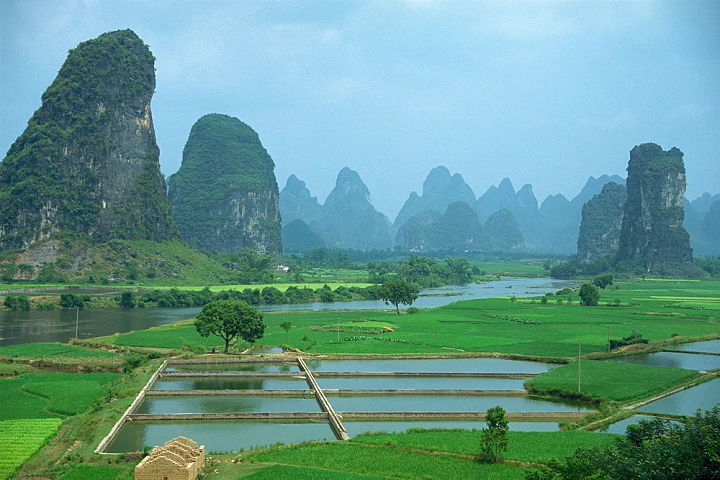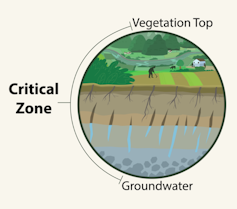
‘Soil observatories’ helping China create more sustainable agriculture
Originally published 2021/05/12
All over the world, agriculture is threatened by degraded soils – and China is no exception. Stripped of carbon from intensive farming, soils erode more easily, host fewer microbes and hold less water and nutrients. Fertilisers and pesticides applied to improve crop yields can leach beneath the soil to pollute groundwater and the surrounding environment.
Looking for ways to make agriculture more sustainable can be difficult because the subject is so vastly complex, and crop and livestock productivity can often be at odds with environmental sustainability. The effects of farming may stretch far beyond the topsoil studied by agricultural scientists. Adopting good sustainability practices requires farmers to buy into the idea, so an appreciation of their expertise and views is important.
Often experts from other countries work in isolation from local scientific teams, risking poor decisions about agricultural practices that don’t acknowledge local conditions and cultures. This means decisions informed by science may not be the best decisions for farmers’ livelihoods or the environment. To avoid this problem, there needs to be more collaboration between scientists and local farmers.
Critical zone observatories
Sinking deep boreholes – down to 200m in places – enabled scientisrs to catalogue how much carbon was stored, the diversity of soil biology and the flow of pesticides, herbicides and fertilisers that leach into the environment. Researchers assessed soil losses through erosion at the surface against rates of soil formation, which is created from the breakdown of minerals from the geology below. They also explored many other processes, providing a comprehensive understanding of how landscapes work and how they are affected by farming.

The research team monitored soils at sites called critical-zone observatories, which complement an international network set up originally to explore how landscapes evolve with ecology (the study of living organisms and their relationship with their physical environment).
Using this deep-monitoring approach, and a vast team of experts, scientists made new discoveries that would have been impossible if they had been working in isolation. There were some worrying findings. Across all sites, huge reserves of fertiliser were found deep below the topsoil.
In China’s Loess plateau, the most erosion-prone landscape on Earth, over 200 million tonnes of nitrogen was found 50-100m under the ground. This equates to the amount of nitrogen that is applied as fertiliser each year around the world.
Similarly, China’s karst landscapes, formed from limestone, have one million tonnes of nitrogen fertiliser flowing through their porous, cavernous geology each year. In highly weathered tropical soil environments, previous research showed that more than 80% of nitrogen leaches below surface depths typically monitored by agricultural researchers. Rather than feed crops, this nitrogen poisons groundwater and feeds aquatic plants that strip rivers and lakes of oxygen when they decompose.
To find the source of this nitrogen and other environmental threats, the China-UK research team asked farmers, advisers and policymakers about their land-management choices. Higher crop yields and a perception that “more is better” dominated their decisions. While policymakers were focused on preserving the environment and feeding the population, farmers seeking to maximise their income were wasting money on fertiliser leaching away.

Passing on the knowledge
The resaerchers next step is to take this new knowledge and make it accessible to policymakers and, eventually, farmers. The goal is to advise on land-management options that benefit crop yield, the environment and economics all at the same time. Cutting fertiliser use is an easy win. This can lower costs to the farmer without affecting yield and results in less fertiliser leaching into the surrounding environment. Decisions that lead to less chemical use save farmers money, but they need to be assured of producing the same yield.
There are also environmental costs that need to be factored in, so the research team has brought in economists who are putting a monetary value on pollution and agricultural land degradation to help policymakers, government and farmers better understand the long-term costs of environmental deterioration. The China-UK research team is working to align the information they produce to the information farmers need to better protect the environment and improve their livelihoods, and help achieve UN sustainable development goals.
Complex information is being simplified for use in computer programs and apps called decision-support tools. The China-UK ream found over 400 of these tools were already in use in China, with most focusing on crop yield and a few exploring environmental effects, but none exploring both the environment and agriculture at the same time.
The computer models that make predictions for these tools are only as good as the available data and understanding. From the data collected, scientists can improve these tools and check their output before using them over larger land areas. A huge market exists for decision-support tools to help with farming worldwide. By adding in the more comprehensive understanding from the projects’s critical-zone observatories in China, new tools will be more reliable and complete.
This is best done by the international partnerships that keep the thinking and debate fresh. Fragmented scientific evidence has been brought together by understanding how farming affects everything, from the crop vegetation to the geology deep below ground, alongside social perspectives from local farmers and government.
Addressing these agricultural and environmental challenges together offers more sustainable, environmentally friendly practices that maintain food production with greater profit to farmers. What the research team has learned in China is also helping to establish more critical-zone observatories in the UK and other countries, including those that focus on the effect of humans on the environment.
SOURCE:
Verified News Explorer Network, 03/09/2021.
https://vnexplorer.net/how-special-soil-observatories-in-china-are-helping-to-create-more-sustainable-agriculture-ez2021306210.html
The Conversation, September 3, 2021. https://theconversation.com/how-special-soil-observatories-in-china-are-helping-to-create-more-sustainable-agriculture-167162